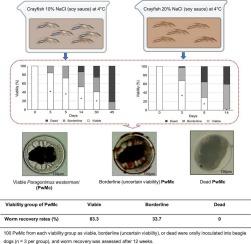威氏并殖吸虫囊蚴在酱油腌制小龙虾中的存活及传染性
IF 3.1
Q2 PARASITOLOGY
引用次数: 0
摘要
卫氏并殖吸虫是一种人畜共患肺吸虫,引起类似肺结核的呼吸道症状。在亚洲,人类感染通常是通过食用含有威氏曼囊蚴的生的或腌制的淡水螃蟹或小龙虾而发生的。随着全球食品贸易的增加和国际旅行期间的偶尔接触,在非流行地区报告了病例,引起了重大的食品安全问题。本研究从韩国海南采集自然感染的淡水小龙虾(Cambaroides similis)。将小龙虾浸泡在含有10%或20%氯化钠(NaCl)的酱油中,在4℃下保存1 ~ 60天。在每个时间点恢复威氏假单胞囊蚴,形态学上分为活的、边缘性的(不确定的)和死亡。为评估感染性,每组取100只威氏假单胞囊蚴口服接种比格犬(每组3只),12周后评估虫体恢复情况。浸泡14 d后,在10% NaCl和20% NaCl酱油中,威氏囊蚴的存活率分别为83.3%和2.0%。10% NaCl处理60天和20% NaCl处理30天后发生完全失活。感染试验显示蠕虫的恢复率为82.5%(活虫)、33.7%(临界虫)和0%(死亡虫)。这些发现表明,即使是高盐的冷藏腌制也不能保证寄生虫的灭活。在常用的烹饪条件下,活的威氏假单胞囊蚴可以在腌制的小龙虾中持续存在。这些结果强调了食源性肺吸虫感染的风险,并强调需要就食用未煮熟或加工不充分的淡水甲壳类动物制定更明确的公共卫生指导。本文章由计算机程序翻译,如有差异,请以英文原文为准。

Survival and infectivity of Paragonimus westermani Metacercariae in soy sauce–marinated crayfish
Paragonimus westermani, a zoonotic lung fluke, causes respiratory symptoms resembling tuberculosis. In Asia, human infections typically occur through the consumption of raw or marinated freshwater crabs or crayfish containing P. westermani metacercariae. With increasing global food trade and occasional exposure during international travel, cases have been reported in non-endemic regions, raising significant food safety concerns. In this study, naturally infected freshwater crayfish (Cambaroides similis) were collected from Haenam, South Korea. Crayfish were marinated in soy sauce containing either 10 % or 20 % sodium chloride (NaCl) and stored at 4 °C for 1–60 days. P. westermani metacercariae were recovered at each time point and morphologically classified as viable, borderline (uncertain viability), or dead. To assess infectivity, 100 P. westermani metacercariae from each group were orally inoculated into beagle dogs (n = 3 per group), and worm recovery was assessed after 12 weeks. After 14 days of marination, the survival rates of P. westermani metacercariae were 83.3 % in 10 % NaCl and 2.0 % in 20 % NaCl soy sauce. Complete inactivation occurred after 60 days in 10 % NaCl and 30 days in 20 % NaCl. Infectivity tests showed worm recovery rates of 82.5 % (viable), 33.7 % (borderline), and 0 % (dead). These findings indicate that even high-salt, cold-storage marination does not guarantee parasite inactivation. Viable P. westermani metacercariae can persist in marinated crayfish under commonly used culinary conditions. These results underscore the risk of foodborne lung fluke infections and emphasize the need for clearer public health guidance regarding the consumption of undercooked or inadequately processed freshwater crustaceans.
求助全文
通过发布文献求助,成功后即可免费获取论文全文。
去求助
来源期刊

Food and Waterborne Parasitology
Immunology and Microbiology-Parasitology
CiteScore
5.10
自引率
4.00%
发文量
38
审稿时长
13 weeks
期刊介绍:
Food and Waterborne Parasitology publishes high quality papers containing original research findings, investigative reports, and scientific proceedings on parasites which are transmitted to humans via the consumption of food or water. The relevant parasites include protozoa, nematodes, cestodes and trematodes which are transmitted by food or water and capable of infecting humans. Pertinent food includes products of animal or plant origin which are domestic or wild, and consumed by humans. Animals and plants from both terrestrial and aquatic sources are included, as well as studies related to potable and other types of water which serve to harbor, perpetuate or disseminate food and waterborne parasites. Studies dealing with prevalence, transmission, epidemiology, risk assessment and mitigation, including control measures and test methodologies for parasites in food and water are of particular interest. Evidence of the emergence of such parasites and interactions among domestic animals, wildlife and humans are of interest. The impact of parasites on the health and welfare of humans is viewed as very important and within scope of the journal. Manuscripts with scientifically generated information on associations between food and waterborne parasitic diseases and lifestyle, culture and economies are also welcome. Studies involving animal experiments must meet the International Guiding Principles for Biomedical Research Involving Animals as issued by the Council for International Organizations of Medical Sciences.
 求助内容:
求助内容: 应助结果提醒方式:
应助结果提醒方式:


